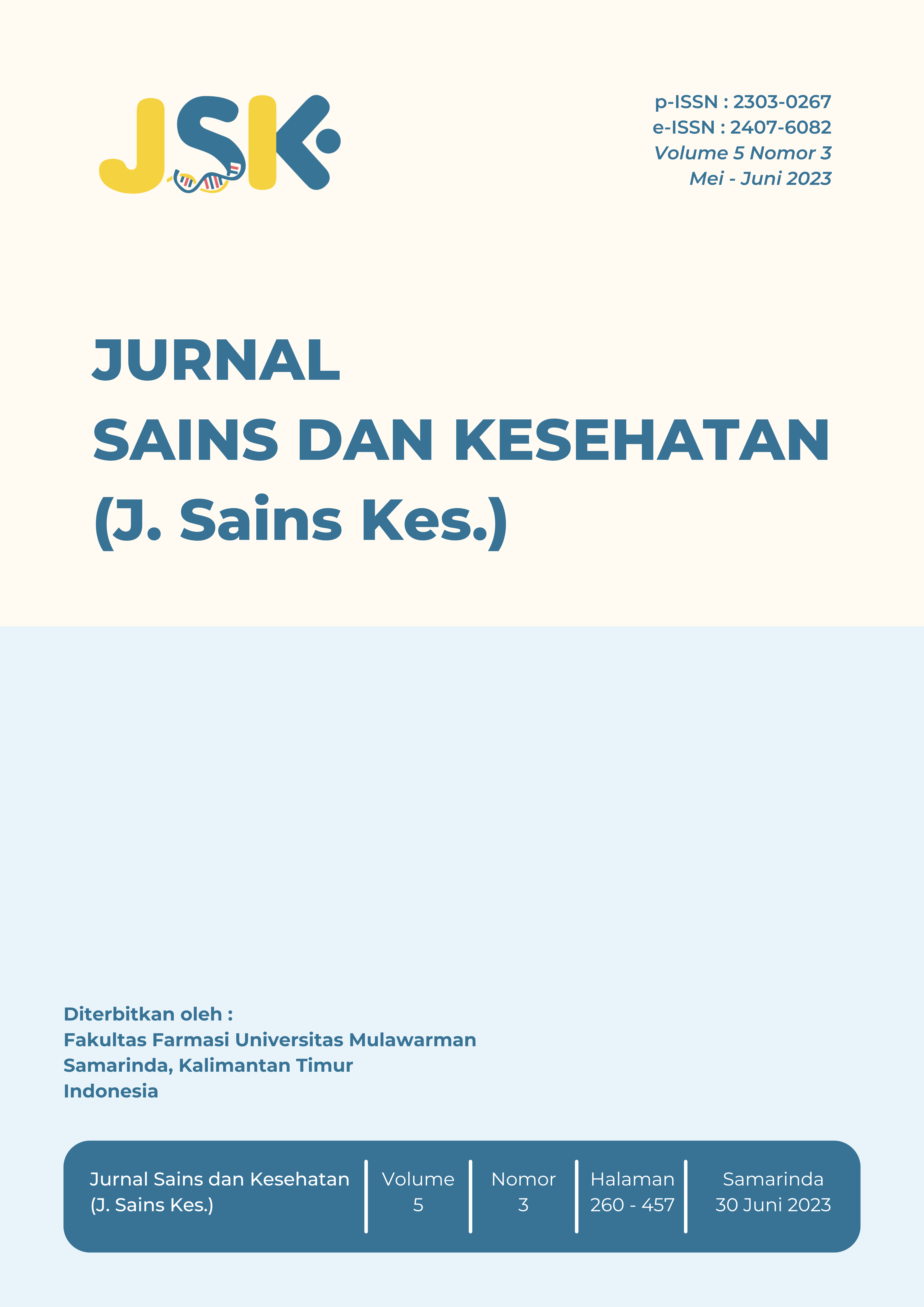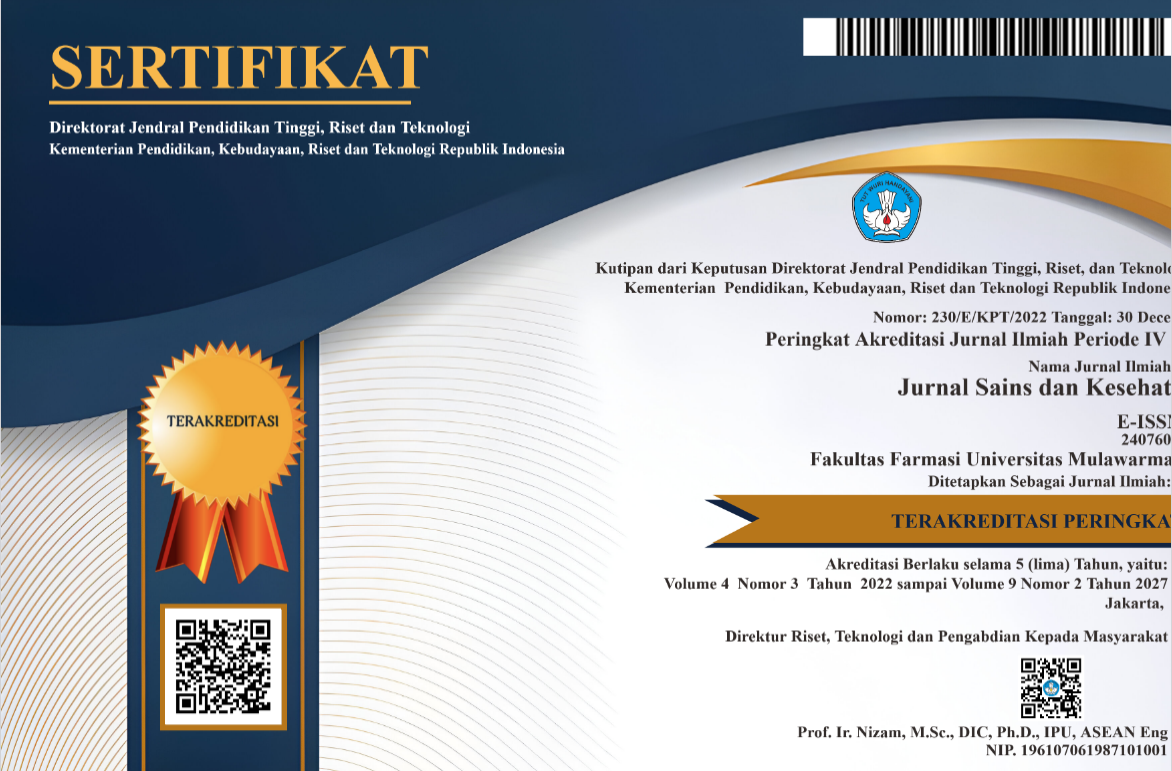Molecular Docking of Secondary Metabolite Compounds of Andrographis Paniculata Plant as Potential Covid-19 Drug Candidate
Keywords:
Andrographis paniculata, Covid-19 drug, Mpro receptor, molecular dockingAbstract
References
M. Suciady, M. Meiliana, and D. N. Hendryanti, “Studi Literatur: Potensi Tanaman Herbal Indonesia sebagai Imunostimulan dan Anti-stress untuk Pencegahan Covid-19 Berbasis Evidence-based Analysis,” Prax. J. Sains, Teknol. Masy. dan Jejaring, vol. 4, no. 1, p. 90, 2021, doi: 10.24167/praxis.v4i1.3607.
D. Kc, “Antiviral properties of medicinal plants of human diseases,” Int. J. Chem. Stud., vol. 8, pp. 2922–2924, 2020.
A. Devidas, “Investigation of Antiviral Properties of Medicinal Plant Extracts Research,” 2014.
P. O. Oladosu, N. Moses, O. P. Adigwe, and H. O. Egharevba, “Potentials of Medicinal Plants with Antiviral Properties: The Need for a Paradigm Shift in Developing Novel Antivirals Against COVID-19,” J. Adv. Med. Med. Res., 2021.
B. Pujiasmanto and I. R. Manurung, “Identification of Sambiloto agroecology as a basis for utilization and conservation of germplasm,” IOP Conf. Ser. Earth Environ. Sci., vol. 1016, 2022.
A. F. Shofa, T. Alam, and N. Nuralih, “Uji Aktivitas Sitotoksik Ekstrak Polar, Semipolar, dan Non-Polar Daun Sambiloto (Andrographis paniculata) terhadap Sel Kanker Hati (HepG2),” J. Kefarmasian Indones., 2022.
T. J. E. Tarigan et al., “Effects of Sambiloto (Andrographis paniculata) on GLP-1 and DPP-4 Concentrations between Normal and Prediabetic Subjects: A Crossover Study.,” Evid. Based. Complement. Alternat. Med., vol. 2022, p. 1535703, 2022, doi: 10.1155/2022/1535703.
M. Sirat et al., “The Effect of Suplementation of Sambiloto (Andrographis paniculata) Extract Through Drinking Water on Total Erythrocytes and Total Leucocytes of Broiler,” J. Ris. dan Inov. Peternak. (Journal Res. Innov. Anim., 2022.
M. Yolanda, S. B. Etika, and R. Riga, “KAJIAN FITOKIMIA DAN SIFAT ANTI BAKTERI JAMUR ENDOFITIK RS-1 PADA RANTING ANDROGRAPHIS PANICULATA (SAMBILOTO) DENGAN MEDIA PERTUMBUHAN BERAS MERAH,” EduMatSains J. Pendidikan, Mat. dan Sains, 2022.
X. Y. Lim et al., “Andrographis paniculata (Burm. F.) Wall. Ex Nees, Andrographolide, and Andrographolide Analogues as SARS-CoV-2 Antivirals? A Rapid Review,” Nat. Prod. Commun., vol. 16, 2021.
A. La Kilo, L. O. Aman, I. Sabihi, and J. La Kilo, “Studi Potensi Pirazolin Tersubstitusi 1-N dari Thiosemicarbazone sebagai Agen Antiamuba melalui Uji In Silico,” Indo. J. Chem. Res., vol. 7, no. 1, pp. 9–16, Jul. 2019, doi: 10.30598//ijcr.2019.7-akr.
N. I. Ischak, L. O. Aman, H. Hasan, A. La Kilo, and A. Asnawi, “In silico screening of Andrographis paniculata secondary metabolites as anti-diabetes mellitus through PDE9 inhibition,” vol. 18, no. February, pp. 100–111, 2023, doi: 10.4103/1735-5362.363616.
Z. R. Mochamad, Universitas indonesia penambatan molekuler beberapa senyawa xanton dari tanaman. 2010.
R. Lelita, R. Gunawan, and W. Astuti, “Studi Docking Molekular Senyawa Kuersetin, Kalkon dan Turunannya Sebagai Inhibitor Sel Kanker Payudara MC-7 (Michigan Cancer Foundation-7),” J. At., vol. 2, no. 2, pp. 190–196, 2017.
R. Rustaman, A. Mutalib, R. E. Siregar, and others, “Simulasi Doking Antibodi Monoklonal Chimeric dan Humanized dengan Reseptor HER-1 dan HER-2,” Indones. J. Appl. Sci., vol. 1, no. 1, 2011.
Y. K. Salimi, L. Ode, Z. Wathoni, and N. Ino, “Jurnal Kimia Sains dan Aplikasi Screening of Secondary Metabolite Compounds of Gorontalo Traditional Medicinal Plants Using the In Silico Method as a Candidate for SARS-CoV-2 Antiviral,” vol. 25, no. 10, pp. 382–393, 2022.
Suharna, “Studi In Silico Senyawa Turunan Flavonoid Terhadap Penghambatan Enzim Tironase,” Skripsi, p. 69, 2012.
N. I. Ischak and D. N. Botutihe, “Preliminary Study of Clinical Antidiabetic Activity of Salam Leaves (Eugenia Polyantha) and Sambiloto Leaves (Andrographis Paniculata) in Type 2 Diabetic Patients,” IOP Conf. Ser. Earth Environ. Sci., vol. 589, no. 1, 2020, doi: 10.1088/1755-1315/589/1/012034.
Z. Jin et al., “Structure of Mpro from SARS-CoV-2 and discovery of its inhibitors,” Nature, vol. 582, no. 7811, pp. 289–293, 2020, doi: 10.1038/s41586-020-2223-y.
F. J. Kelutur, “Sterol Constituents of Sea Fan (Gorgonia mariae) as Potential Candidates of MPro Protein SARS-CoV-2 Inhibitor: in silico Study,” Indo. J. Chem. Res., 2022.
A. Mishra, Y. Pathak, G. Choudhir, A. Kumar, S. K. Mishra, and V. N. Tripathi, “Abstract 712: Anticancer natural compounds as potential inhibitors of novel coronavirus (COVID19) main protease: An in-silico study,” COVID-19 and Cancer, 2021.
A. Agusta, D. Wulansari, Praptiwi, A. Fathoni, L. Oktavia, and A. P. Keim, “Papuacerdrus papuana (f. Muell) h.l.li., A NEW SOURCE FOR TWO BIOACTIVE DITERPENES: FERRUGINOL AND transCOMMUNIC ACID THAT VIRTUALLY ACTIVE AGAINST SARS-COV-2,” RASAYAN J. Chem., 2022.
M. F. U. Rehman et al., “Effectiveness of Natural Antioxidants against SARS-CoV-2? Insights from the In-Silico World.,” Antibiot. (Basel, Switzerland), vol. 10, no. 8, Aug. 2021, doi: 10.3390/antibiotics10081011.
M. M. Al-Sanea et al., “Strawberry and Ginger Silver Nanoparticles as Potential Inhibitors for SARS-CoV-2 Assisted by In Silico Modeling and Metabolic Profiling.,” Antibiot. (Basel, Switzerland), vol. 10, no. 7, Jul. 2021, doi: 10.3390/antibiotics10070824.
P. Khanal et al., “Combination of system biology to probe the anti-viral activity of andrographolide and its derivative against COVID-19.,” RSC Adv., vol. 11, no. 9, pp. 5065–5079, Jan. 2021, doi: 10.1039/d0ra10529e.
M. Nazari, M. Nazari, S. P. Arabani, and M. P. Nazarii, “Anti-Inflammation Prediction of Orthosiphon Stamineus Extract Against Covid19 (In Silico Study),” Int. J. Eng. Technol. Sci., 2021.
R. S. Kalra et al., “COVID19-inhibitory activity of withanolides involves targeting of the host cell surface receptor ACE2: insights from computational and biochemical assays.,” J. Biomol. Struct. Dyn., vol. 40, no. 17, pp. 7885–7898, Oct. 2022, doi: 10.1080/07391102.2021.1902858.
N. Vm, “Anti-Inflammation Effects of Rosmarinus Officinalis Extract Against Covid19 Virus (In Silico Study),” Bioequivalence & Bioavailab. Int. J., 2021.
G. V. S. Kumar, R. Manivannan, and B. Nivetha, “In Silico Identification of Flavonoids from Corriandrum sativum Seeds against Coronavirus Covid-19 Main Protease,” J. Drug Deliv. Ther., 2021.
Downloads
Published
Issue
Section
Deprecated: json_decode(): Passing null to parameter #1 ($json) of type string is deprecated in /home/jskff/public_html/plugins/generic/citations/CitationsPlugin.php on line 68
How to Cite
Similar Articles
- Norhayati Norhayati, Andika Andika, Aris Purwanto, In Silico Study of Bajakah Compounds (Spatholobus suberectus) to ProteaseSARS-CoV-2 Inhibitor , Jurnal Sains dan Kesehatan: Vol. 5 No. 2 (2023): J. Sains Kes.
- Denis Mery Mirza, Burhan Ma’arif, Ira Purbosari, Suko Hardjono, Mangestuti Agil, Prediksi Aktivitas Fitoestrogenik Senyawa Golongan Flavonoid terhadap Receptor Estrogen α (ER- α) dengan pendekatan In Silico , Jurnal Sains dan Kesehatan: Vol. 3 No. 4 (2021): J. Sains Kes.
- Muhammad Despriansyah Romadhan, Putri Mahirah Afladhanti, Ni Made Dyah Gayatri, Identifikasi Senyawa Aktif Pala (Myristica fragrans) sebagai Terapi Komplementer Antihipertensi melalui Penghambatan Reseptor ACE: Sebuah Studi Penambatan Molekuler , Jurnal Sains dan Kesehatan: Vol. 5 No. 3 (2023): J. Sains Kes.
- Okta Muthia Sari, Aditya Maulana Perdana Putra, Yusrinie Wasiaturrahmah, Nahdiya Rahmah, Analisis Faktor yang Berhubungan dengan Potensi Interaksi Obat Pasien Covid-19 di Salah Satu Rumah Sakit Kalimantan Selatan , Jurnal Sains dan Kesehatan: Vol. 5 No. 5 (2023): J. Sains Kes.
- Riga Riga, Mauline Adia Silvani, Wandi Oktria, Edi Nasra, Desy Kurniawati, Dewi Meliati Agustini, Jamur Endofitik BJS-3 Asosiasi Sambiloto (Andrographis paniculata): Skiring Fitokimia dan Aktivitas Antioksidan , Jurnal Sains dan Kesehatan: Vol. 5 No. 5 (2023): J. Sains Kes.
- Adelia Putri Febbiana, Thania Raya Tri Moerbi, Widya Dhealova Savita, Devita Natashya, Dea Rahma Heldestasia, Naura Nurnahari, Mubarika Sekarsari Yusuf, Studi In Silico Potensi Senyawa Jambu Biji (Psidium guajava) sebagai Inhibitor α-Amilase dan α-Glukosidase , Jurnal Sains dan Kesehatan: Vol. 6 No. 2 (2025): J. Sains Kes.
- Gusnia Meilin Gholam, Analisis Penambatan Molekuler Senyawa Mangiferin dari Mahkota Dewa (Phaleria macrocarpa) terhadap Sap 5 Candida albicans , Jurnal Sains dan Kesehatan: Vol. 5 No. 3 (2023): J. Sains Kes.
- Mauline Adia Silvani, Riga Riga, Dewi Meliati Agustini, Aktivitas Antioksidan Jamur Endofitik BS-1 yang Diisolasi dari Bunga Sambiloto Menggunakan Beras Putih sebagai Media Pertumbuhan , Jurnal Sains dan Kesehatan: Vol. 5 No. 2 (2023): J. Sains Kes.
- Ira Purbosari, Muhammad Wahyono, Profil Pengetahuan dan Keyakinan Vaksinasi Covid-19 Aztrazeneca dan Sinovac sebagai Upaya Pencegahan Covid-19 pada Warga Surabaya , Jurnal Sains dan Kesehatan: Vol. 4 No. 3 (2022): J. Sains Kes.
- Taureni Hayati, Mirna Albertina Wijaja, Sri Murtiyani Kusumastuti, Profil Hematologi Pasien Covid-19 Berdasarkan Beratnya Kasus , Jurnal Sains dan Kesehatan: Vol. 4 No. 3 (2022): J. Sains Kes.
You may also start an advanced similarity search for this article.




